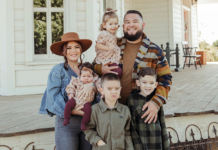
Inez Ramirez knows what it’s like to be the new kid in school.
And, for that school to be filled with peers and teachers speaking a language foreign to her small ears; for that school to follow customs far more liberal than her upbringing.
Today as a teacher of English Language Learners at Butterfield Elementary School, she understands what her students are experiencing. Ramirez was an English-as-a-second-language student, before English immersion became the law of the state.
“I understand what students are going through. The fears of the culture shock when they come to our country,” she explains. “Their lack of understanding of this country, the regulations and the system of what’s expected of them.
“I lived it when I became a citizen.”
But she says she knows something that has proved helpful as the number of languages spoken changes every single year, as families move in and out from all over the world: No matter what the language of origin, children adapt fast to English.
The Maricopa Unified School District currently has 24 different spoken languages; a number that at times rises into the 40s, as one family can add an entirely different language as they move in. While the number of languages is lower than its peak, the district is still experiencing new languages, with a growth in Asian languages.
Spanish is the most significantly spoken language, explains Gretchen Brown, who oversees the district’s English immersion programs. The second most common is Vietnamese, which has 16 student speakers.
District schools regularly celebrate all of the cultures in a variety of ways. Teachers can receive a benefit from the parents who may struggle more than their immersed students: gifts of food from around the globe.
Other languages in the district are Afrikaans, Cambodian, Creole, Dutch, Pilipino, Finnish, French, German, Italian, Korean, Laotian, Mandarin, Navajo, Papago, Polish, Portuguese, Serbian, Swahili, Tagalong, Thai and Marshallese.
Every student who enters the school system with another prominent language spoken at home is tested for language proficiency. Some students may speak English well but need assistance with grammar or reading, which puts them into the largest category of Maricopa English immersion students, listed as “intermediate.”
Students who speak and understand little English are placed into more intense classes “below proficient” programming, which is usually for a limited time as they learn.
The two schools with the highest population of English immersion students, Butterfield and Maricopa elementary schools, may often offer classes of all English immersion learners, if there are 20 or more English immersion students in a class. If there are fewer than 20 such students, each student receives individual plans the teacher uses to ensure they understand a lesson and embrace the English language, through student pairing, repetition and other techniques Ramirez says are valuable to proficient English speakers as well.
Student plans could direct, for instance, how many times a word or lesson or action should be repeated, as the student picks it up.
Spanish-speakers are the most common, with 522 students of the district’s total 5,838, who speak fluent Spanish. Brown says while Latin families have support among each other as a larger group, families from other parts of the world often come with a stronger immediate family support system, which moved to the states in advance.
Many students already are proficient bilingual speakers, with 219 currently tested as ELL students, 124 of whom are considered “intermediate” in needing support to become proficient speakers, but able to communicate above “below proficient.”
“They pick it up super fast, especially among their peers,” Brown says. “They are all English speaking when they go out to play on the playground. We can only provide English instruction and that is by state law.”
Because students are immersed in English in school, oftentimes the parents have more needs when it comes to adjusting to U.S. culture, where students and parents have more rights and are encouraged to be more involved. Parents from other cultures may often feel uncomfortable being involved in their school, so it is encouraged.
Schools regularly hold parent nights led by the students themselves in a way to encourage parental involvement and level of comfort, Brown says. Translation services are available for parents.
“We have a lot of cultures here in Maricopa,” she adds. “In November, we focused on cultural diversity in our schools. We brought in guest speakers, have family nights about diversity, and showcased all of the different languages or countries. It does make us unique.”
Bianca Lopez is mother of four children who have immigrated with her to Maricopa, where she says the school system opens a much brighter future for her children.
“There’s a huge difference in the educational system between Mexico and the U.S.,” she said, through a translator. “We moved here for a better future. A better future for our children.”
But, she added, it’s one that doesn’t have to leave behind her ethnic culture.
“Our culture, our desires, are just like in any country,” Lopez said. “When we come here, we bring our history, our culture, our food, and teach our children never to forget where we came from, to be open, heard and to become part of this country’s future.”
***ADVERTISEMENT*** Ramirez uses her personal experiences to reach students, in her class which includes English Language Learners. As they learn a new word or subject, she wants them to touch or see examples.
“Coming from a culture where the customs are definitely different, the food is different. Coming from Mexico, the education system is so drastically different – going to school up to a certain level is not mandatory,” Ramirez says. “And then it’s more of a privilege to get education, it’s so expensive. The culture, the traditions – they tell me that the United States is a little bit more liberal than other countries. Even our students who come from Vietnam – they’re just shocked how liberal it is.
“Our freedom of speech that other countries don’t have. Our freedom to dress – they get a little bit shocked, and withdrawn … what can I say or not say, or speak up? They are shocked that they get to participate in computer lab, physical education, choir, music and band.”
With support, the quickly embrace the school, she adds, and the language.
“By December, they will be talking their ears off,” she said. “And now I have to give warnings. It’s beautiful to see that with the kiddos, an amazing blessing to be able to be part of that with the students.”
Teri Ponticello oversees Native American education programs, which bring to light another challenge for some youth beyond language: cultural adaptation. Many Native American families teach their children to learn in a manner very different from the educational system.
“Because culturally and traditionally, they’re used to the whole picture, where everything is important,” Ponticello explains. “So we have a real challenge bullet-pointing and summarizing – it goes back several generations, with storytelling, and the way they are used to telling stories very verbally.”
Abstract math concepts for Native American populations can be a challenge, after being raised to count tangible objects, and Ponticello uses federal grant money to help students transition.
“Our focus this year is primarily on math, and how doing simple addition without having our hands on something to manipulate,” she says. “It’s a challenge, taking that abstract concept – how do you make it real?”
“It’s a whole child approach,” she adds. “Looking at all of their needs, and being very sensitive to their cultural upbringing and heritage.”
Angelia Ebner teaches English Language Learners at Maricopa Elementary, and as a single language speaker herself, she says she appreciates the value students gain from retaining bilingual speech. But she also cautions the labels as being entirely about language – as language proficiency test questions can at time confuse a student from a very different cultural background.
“Maybe if they just got here, they used symbols and not letters,” she says. “It’s a completely different system. Some test questions are based on cultural background, questions like ‘what ingredient is missing from applesauce,’ or questions about owls that to Native Americans have serious religious connotations.”
Ramirez says students themselves bring a new level of education to their peers, as they learn on so many levels in their new home.
“As a parent myself, these students just enrich our lives,” she says. “They expose our children to culture, to their traditions. They’re able to share with them what other countries are going through – political, religious and in education, to show pictures, videos and their history is amazing.”
Maricopa Elementary School principal Jennifer Robinson agrees that while the diverse cultures provide a challenge to ensure every student’s individual needs are met – “we feel very fortunate to have diverse cultures, diverse abilities. It makes us more well-rounded.
“We know that each child is unique and different and each brings something special to our school.”

![‘Best moms’ InMaricopa recognized Best Mom's 2024 photo taken at Karsten's Ace Hardware on May 11th, 2024. [Bryan Mordt]](https://www.inmaricopa.com/wp-content/uploads/2024/05/Best-Mom-2024-1-218x150.jpg)





![Maricopa sheds tears amid Maui wildfires that killed dozens For Maricopa resident Janelle Gomez, the sorrow mirrors the loss of a family member. [Brian Petersheim]](https://www.inmaricopa.com/wp-content/uploads/2023/08/Gomez-218x150.jpg)
![Embracing Freedom: Celebrating the Fourth of July Councilmember Vincent Manfredi at Great American 4th 2021 [Victor Moreno]](https://www.inmaricopa.com/wp-content/uploads/2023/07/2021-Great-American-4th-e1688414543522-218x150.jpg)


![Carl’s Jr plans to “open soon” An exterior view of the new Carl's Jr. restaurant along John Wayne Parkway on May 7, 2024. [Elias Weiss]](https://www.inmaricopa.com/wp-content/uploads/2024/05/E1C66482-CB4C-4FD0-BA30-35CECE93F4BE-218x150.jpeg)
![Traffic change to reduce backup at Villages intersection The intersection at Butterfield Parkway and West Edison Road on May 10, 2024. [Brian Petersheim Jr.]](https://www.inmaricopa.com/wp-content/uploads/2024/05/PJ_5644-218x150.jpg)


![State: Pinal County fire activity concerning Tucson's Northwest Fire District crew members assist in firefighting efforts on the "Flying Bucket Fire" approximately 15 miles southwest of Maricopa on May 8, 2024. [Northwest Fire District]](https://www.inmaricopa.com/wp-content/uploads/2024/05/GNEq06pbwAA6JlT-100x70.jpg)
